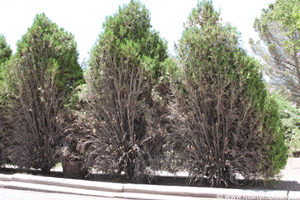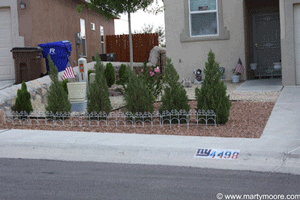What
To Plant
In Your
Southwest
Garden

2a.gif) Nice Arborvitae Windbreak |
||
Arborvitae Trees |
||
Arborvitae trees do very well as windbreaks in the desert Southwest. Arborvitae have very few insect and disease problems, as long as they are not allowed to become stressed from lack of water. Stressed trees invite spider mite infestations. The trees are evergreen, require full sun and water usage is low to moderate. There are several different varieties and shapes and sizes vary widely. The American Arborvitae is wide and cone shaped, while the globe arborvitae is rounded and the pyramidalis is thin and columnar. Most Arborvitae are fairly slow growers, but the Thuga Green Giant can grow three to five feet per year. As windbreaks go, Arborvitae are probably one of the best, because of the density of the trees. Old trees that have not been well cared for can be very scraggly in appearance and old trees don't hold up well to drastic sheering, as seen in these photos.
|
||
|
2.gif) Old Arborvitae Tree |
|
|
||
|
||
|
||
2.gif)
2.gif)

